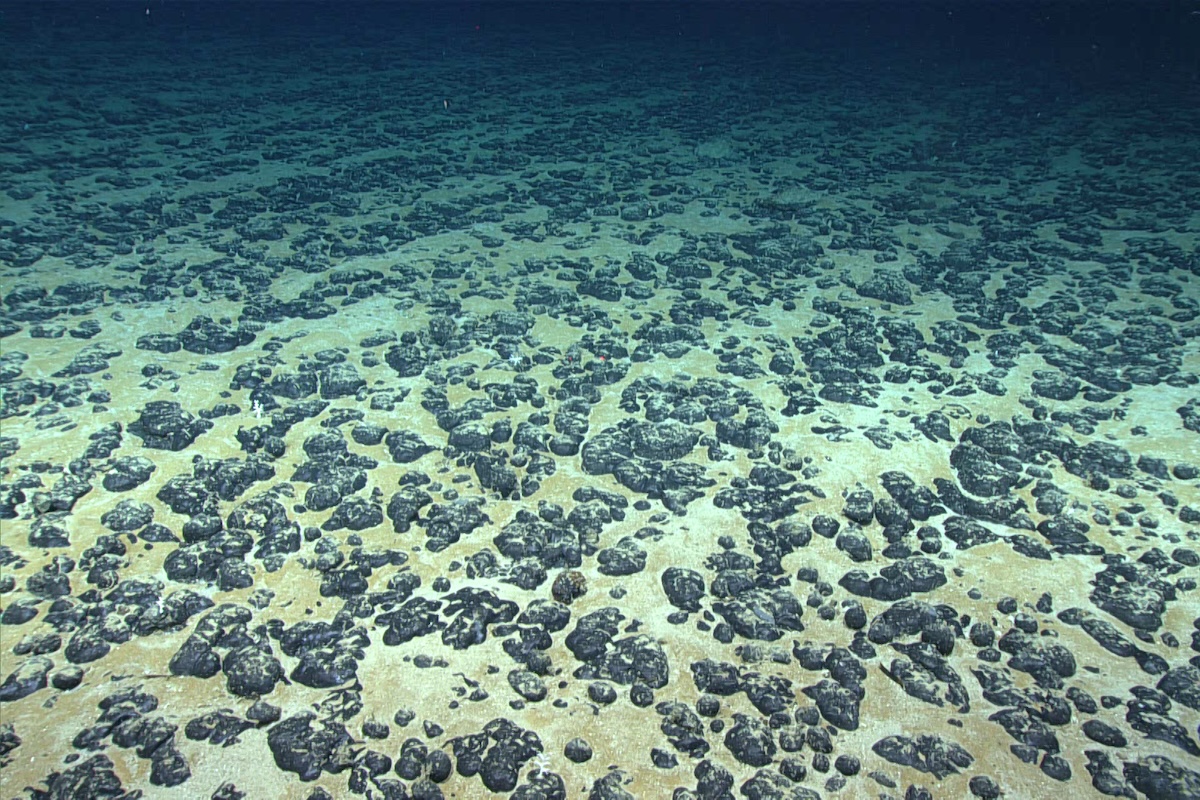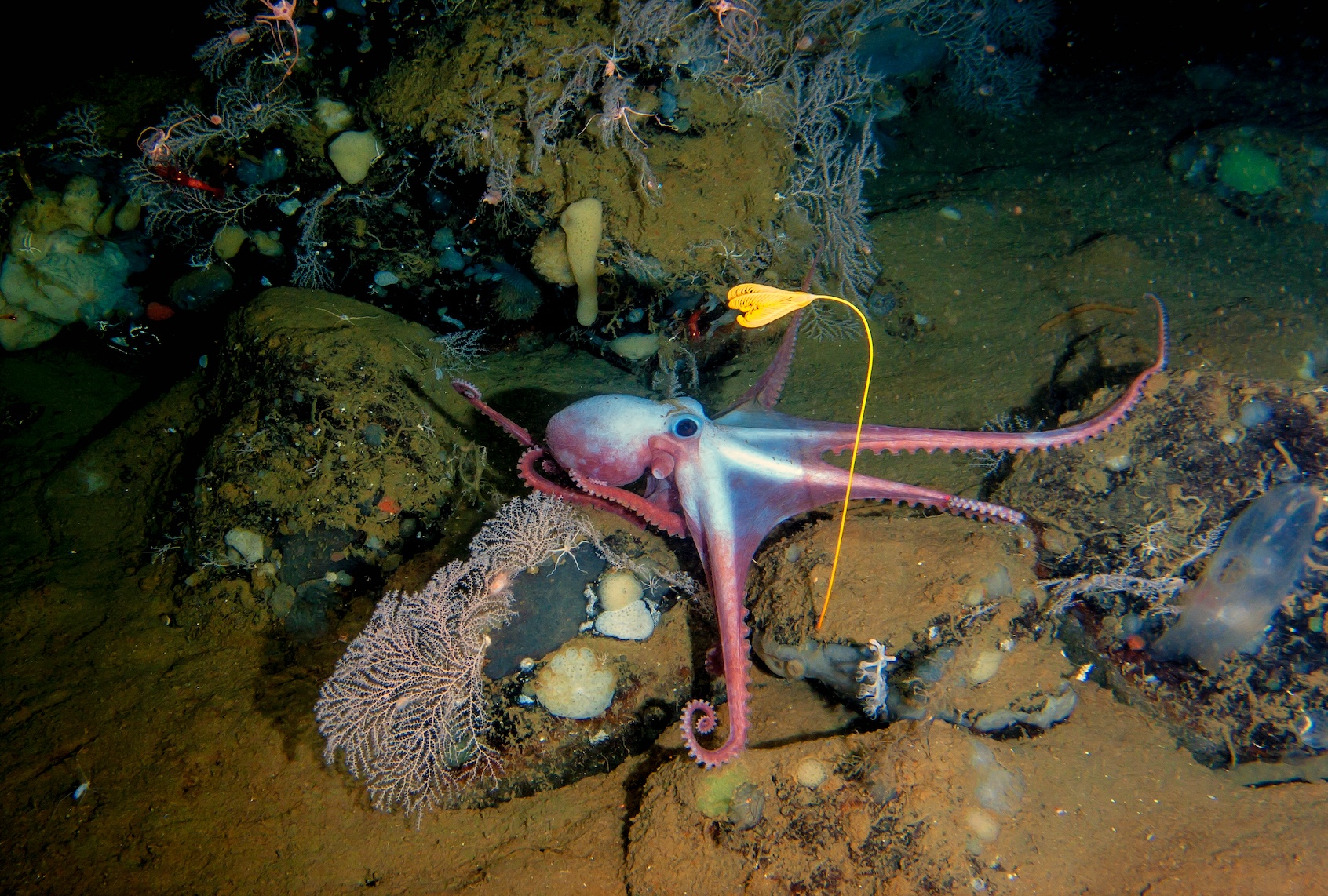When the submarine plunged to about 1,500 meters below sea level, ecologist Jeff Drazen asked the pilots to cut the strobe lights that had been guiding them through the pitch-black waters. For a moment, they continued falling to the sea floor in complete darkness.
Then, the creatures of the deep sea began dazzling the crew with a striking display of bioluminescent lights, emitting signals to one another as they encountered this new strange object in their habitat.
“It’s like you are falling through the stars,” Drazen told Salon in a phone interview. “There are twinkling lights everywhere.”
Thousands of meters below sea level, the creatures that live in the deep sea survive without direct sunlight, plants or the warmth of the sun. Much of the deep ocean is vacant, with extremely cold, lightless regions making it difficult for life as we know it to survive. Yet spectacular animals reside there, including the vampire squid, which has the largest eyes proportional to its body of any animal (though this cephalopod is neither a vampire or a squid); a pearly white octopus nicknamed “Casper”; and, of course, the toothy Angler fish that became an internet sensation when one rose to the surface earlier this year.
Last month, President Donald Trump issued an executive order promoting deep sea mining, which is currently prohibited under international law. And on Tuesday, the Department of the Interior announced it is initiating the process to evaluate a potential mineral lease sale in the waters offshore American Samoa. As industry eyes nodules found on the ocean floor as a potential way to extract nickel, copper and cobalt for making things like electric car batteries, scientists warn that deep sea mining is likely to be detrimental to life that exists there.
"We’re the first people that have ever seen some of the sites that we dive at."
“We don't know that much about the deep sea because we have explored so little,” said Jim Barry, a seafloor ecologist at the Monterey Bay Aquarium Research Institute, “We should make sure we know what is there before we do much to destroy things.”
The deep sea begins at about 200 meters below sea level, where light starts to diminish in a region called the twilight zone. The deepest part of the ocean lies in the Mariana Trench in the western Pacific Ocean, where the ocean floor lies almost 11,000 meters below sea level — a height that is taller than Mount Everest.
The ocean covers 71% of the Earth’s surface, so classifying the deep sea as a single habitat is like classifying all land as one habitat. Just as on land there are deserts, grasslands, rainforests and the arctic, so too in the deep sea there are numerous different ecosystems that differ by geography, temperature and the animals that live there. Earlier this month, scientists witnessed the first volcanic eruption underwater for the first time.
Want more health and science stories in your inbox? Subscribe to Salon's weekly newsletter Lab Notes.
“Even if you're just looking at forests in the U.S., you wouldn't think that the forest on the East Coast is going to look the same as the forest on the West Coast,” Drazen said. “The same is true on the sea floor, and we actually have data that shows this: The communities that you find in the east on nodules are not the same as the communities you find in the west on nodules.”
One study published in Science earlier this month found that with 44,000 deep-sea dives, just 0.001% of the deep seafloor has been visually observed — which is roughly the size of Yosemite National Park. The rest is a black box. The study authors also note “Ninety-seven percent of all dives we compiled have been conducted by just five countries: the United States, Japan, New Zealand, France, and Germany. This small and biased sample is problematic when attempting to characterize, understand, and manage a global ocean.”
 Most of the seafloor explored during Dive 07 of the 2019 Southeastern U.S. Deep-sea Exploration was covered with these manganese nodules, the subject of the Deep Sea Ventures pilot test nearly five decades ago. (Image courtesy of the NOAA Office of Ocean Exploration and Research, 2019 Southeastern U.S. Deep-sea Exploration.)Another 2023 study estimated that scientists had identified fewer than 1,000 of up to 8,000 species in one region of the deep sea called the Clarion–Clipperton zone, which stretches the width of the continental United States and is a potential target for deep sea mining.
Most of the seafloor explored during Dive 07 of the 2019 Southeastern U.S. Deep-sea Exploration was covered with these manganese nodules, the subject of the Deep Sea Ventures pilot test nearly five decades ago. (Image courtesy of the NOAA Office of Ocean Exploration and Research, 2019 Southeastern U.S. Deep-sea Exploration.)Another 2023 study estimated that scientists had identified fewer than 1,000 of up to 8,000 species in one region of the deep sea called the Clarion–Clipperton zone, which stretches the width of the continental United States and is a potential target for deep sea mining.
Scientists explore these regions in submarines like Drazen’s, or they use remote-operated vehicles to collect samples and map the ocean floor. Depending on the depth of the seafloor being studied, it can take these vehicles hours to reach the bottom, Barry said.
Each time scientists go on a deep sea expedition, they encounter previously unknown species. In 2018, a team at MBARI discovered an “Octopus Garden” of as many as 20,000 octopuses nested on the seafloor off the coast of California in the largest gathering of octopuses on the planet. In total, four of these gardens have been discovered around the world thus far.
Each time scientists go on a deep sea expedition, they encounter previously unknown species.
In other expeditions, scientists have discovered creatures that evolved their enzymes to function better at high pressure, as the ocean pressure increases by about one atmosphere every 10 meters — which is a greater change than the pressure drop experienced in a commercial airplane. Some invertebrates can live for thousands of years, and the oldest known sea sponges have been dated to be 18,000 years old, said Lisa Levin, an oceanographer at the Scripps Institution of Oceanography.
Overall, there are more new species being discovered than there are taxonomists to properly catalog them. The deep sea has been called Earth’s last frontier as the only largely untouched place on the planet. For scientists on these trips, exploring the deep sea seems almost like they are exploring the moon or a distant planet.
“We’re the first people that have ever seen some of the sites that we dive at,” Barry told Salon in a phone interview. “In fact, almost any site you go to offshore, unless you've been there before, none of it's been viewed.”
Many species in the deep sea have developed adaptations like bioluminescence or large eyes that help them navigate the dark waters. Others living in regions called oxygen-minimum zones — also known as “dead zones” or “shadow zones” — have developed elaborate breathing structures that look like lungs outside of their bodies in order to maximize the surface area they use to absorb oxygen, Levin said.
On the seafloor, you can find canyons, volcanoes and vast abyssal planes. In some regions called chemosynthetic ecosystems, creatures produce food using the energy from chemical reactions rather than sunlight.
“Deep water isn't uniform, it's kind of layered, and there are different water masses,” Levin told Salon in a video call. “It's really a whole mosaic of ecosystems and habitats.”
As remote as it may seem, the deep sea is just one degree of separation from anyone who eats seafood, Drazen said. The deep sea provides food to many species in shallower waters, like the swordfish, which dives up to 1,200 meters to feed.
The ocean also produces half of the oxygen we breathe on land and is the largest carbon sink on Earth, absorbing about 30% of all carbon dioxide emissions from humans. With the deep sea covering so much of the ocean’s volume, it plays a major role in reducing the effects of global heating. Unfortunately, as CO2 emissions increase, it acidifies the ocean, which can make it less hospitable for life. Some crustaceans, for example, have a hard time developing hard outer shells made of calcium carbonate if the water is too acidic.
Not only that, but the creatures of the deep sea could provide scientists with molecules or compounds that help them develop better medicines or lead to other breakthrough discoveries. In the early 1980s, for example, scientists synthesized ziconotide, a natural pain-killer 1,000 times stronger than morphine without the addictive side effects. The molecule came from the Conus magus, a sea snail found in the deep sea. Overall, more than 60% of our drugs come from analogs in nature.
“If you think about pharmaceuticals, there's a repository of genetic material down there with all these weird animals,” Barry said. “People want to collect deep sea animals to see if they have important, novel chemicals that could have some use for us, whether it might be antibiotics or cancer treatments or something else.”
Scientists are also still uncovering exactly how sensitive the deep sea is to environmental changes and human impacts. However, compared to shallower waters, which are more easily subjected to changes in things like temperature, acidity or oxygen levels, these environmental changes take longer to reach the deep sea. As a result, creatures of the deep sea are likely to be more sensitive and vulnerable to changes that do occur in their environment.
“Animals that inhabit shallow waters have evolved to cope with variability in environmental conditions, but in the deep sea, there's very little change in oxygen or temperature or pH across the year,” Barry said. “A similar change in pH or oxygen [that occurs at shallower levels], might be far less tolerable for animals in the deep sea.”
Additionally, deep sea creatures are impacted by changes that occur in regions closer to the surface because many rely on food that falls from those heights. About 90% of food sources are lost every 1,000 meters deeper you go in the ocean, so any disruptions to the food supply could be detrimental to sealife at these depths, Barry said.
“When the productivity of the surface water changes, that affects the amount of detritus, or dead material, that sinks to the deep sea floor that is the food supply for those organisms,” Drazen said. “That is reducing the food supply to the deep sea.”
We need your help to stay independent
Many of the minerals involved in proposed deep sea mining operations are located on black, potato-shaped nodules that lie on the seafloor. Yet a community of animals lives on the nodules themselves, and they would be eradicated if they are mined, said Lauren Mullineaux, a senior scientist at the Woods Hole Oceanographic Institution.
Additionally, mining operations scrape up the seafloor, producing sediment plumes that can disrupt an area more than a kilometer away from the operating site, Mullineaux said. Even a fine dusting of this sediment might change the habitat enough to kill some of those species, she explained.
“It can take many decades for the habitat to look like it did before it was mined,” Mullineaux told Salon in a phone interview.
The ocean is a globally shared resource, and stewarding the deep sea may be society’s last chance to protect the remaining virgin Earth. The majority of creatures living in the abysmal sea remain unknown to us, but in order to protect them, we must first know they exist. After all, these creatures surely have a lot to teach us about how to survive and evolve in an increasingly harsh environment.
“If we want to be sustainable stewards of the resources that we depend on, it would be nice to know what is there first,” Barry said.


